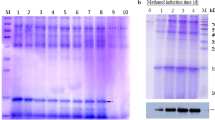Abstract
Yeastolate is effective in promoting growth of insect cell and enhancing production of recombinant protein, thus it is a key component in formulating serum-free medium for insect cell culture. However, yeastolate is a complex mixture and identification of the constituents responsible for cell growth promotion has not yet been achieved. This study used sequential ethanol precipitation to fractionate yeastolate ultrafiltrate (YUF) into six fractions (F1–F6). Fractions were characterized and evaluated for their growth promoting activities. Fraction F1 was obtained by 65% ethanol precipitation. When supplemented to IPL-41 medium at a concentration of 1 g L−1, fraction F1 showed 71% Sf-9 cell growth improvement and 22% β-galactosidase production enhancement over YUF (at 1 g L−1 in IPL-41 medium). However, the superiority of F1 over YUF on promoting cell growth gradually diminished as its concentration in IPL-41 medium increased. At 4 g L−1, the relative activity of F1 was 93% whereas YUF was 100% at the same concentration. At 1 g L−1, four other fractions (F2–F5) precipitated with higher ethanol concentrations and F6, the final supernatant, showed growth promoting activities ranging from 32 to 80% as compared to YUF (100%). Interestingly, a synergistic effect on promoting cell growth was observed when F6 was supplemented in IPL-41 medium in presence of high concentrations of F1 (>3 g L−1). The results suggest that ethanol precipitation was a practical method to fractionate growth-promoting components from YUF, but more than one components contributed to the optimum growth of Sf-9 cells. Further fractionation, isolation and identification of individual active components would be needed to better understand the role of these components on the cell metabolism.





Similar content being viewed by others
References
Bédard C, Kamen A, Massie B (1994) Maximization of recombinant protein yield in the insect cell/baculovirus system by one-time addition of nutrients to high-density batch cultures. Cytotechnol 15:129–138
Bridson EY, Brecker A (1970) Design and formulation of microbial culture media. In: Methods in microbiology, vol. 3A. Academic Press, pp 252–256
Burteau CC, Verhoeye FR, Mols JF, Ballez JS, Agathos SN, Schneider YJ (2003) Fortification of a protein-free cell culture medium with plant peptones improves cultivation and productivity of an interferon-gamma-producing CHO cell line. In vitro Cell Dev Biol Anim 39:291–296
Franek F, Hohenwarter O, Katinger H (2000) Plant protein hydrolysates: preparation of defined peptide fractions promoting growth and production in animal cells cultures. Biotechnol Prog 16:688–692
Hasegawa A, Yamashita H, Kondo S, Kiyota T, Hayashi H, Yoshizaki H, Murakami A, Shiratsuchi M, Mori T (1988) Proteose peptone enhances production of tissue-type plasminogen activator from human diploid fibroblasts. Biochem Biophys Res Commun 150:1230–1236
Heidemann R, Zhang C, Qi H, Rule JL, Rozales C, Park S, Chuppa S, Ray M, Micheals J, Konstantin K, Naveh D (2000) The use of peptones as medium additives for the production of a recombinant therapeutic protein in high density perfusion cultures of mammalian cells. Cytotechnol 32:157–167
Ikonomou L, Bastin G, Schneider YJ, Agathos SN (2001) Design of an efficient medium for insect cell growth and recombinant protein production. In vitro Cell Dev Biol Anim 37:549–559
Inlow D, Shauger A, Maiorella B (1989) Insect cell culture and baculovirus propagation in protein-free medium. J Tissue Culture Methods 12:13–16
Kasprow RP, Lange AJ, Kirwan DJ (1998) Correlation of fermentation yield with yeast extract composition as characterized by near-infrared spectroscopy. Biotechnol Prog 14:318–325
Kelly M (1983) Yeast extract. In: Godfrey T, Reichelt M (eds) Industrial enzymology, the application of enzymes in industry. Nature press, New York, pp 457–464
Maiorella B, Inlow D, Shauger A, Harano D (1988) Large-scale insect cell-culture for recombinant protein production. Bio/Technol 6:1406–1410
Minamoto Y, Ogawa K, Hideki A, Iochi Y, Misugi K (1991) Development of a serum-free and heat sterilizable medium and continuous high-cell density cell culture. Cytotechnol 5:S35–S51
Nyberg GB, Balcarcel RR, Follstad BD, Stephanopoulos G, Wang DIC (1999) Metabolism of peptide amino acids by Chinese hamster ovary cells grown in a complex medium. Biotechnol Bioeng 62:423–335
Peptone Technical Manual, BD Biopharmaceutical Production, BD Biosciences, Sparks, MD, USA. May 2002
Potvin J, Fonchy E, Conway J, Champagne CP (1997) An automatic turbidimetric method to screen yeast extract as fermentation nutrient ingredients. J Microbial Methods 29:153–160
Rasmussen B, Davis R, Thomas J, Reddy P (1998) Isolation, characterization and recombinant protein expression in Veggie-CHO: a serum-free CHO host cell line. Cytotechnol 28:31–42
Schlaeger EJ (1996) The protein hydrolysate, Primatone RL, is a cost-effective multiple growth promoter of mammalian cell culture in serum-containing and serum-free media and displays anti-apoptosis properties. J Immunol Methods 194:191–199
Scopes RK (1987) Protein purification, 2nd edn. Chapter 3: separation by precipitation. Springer-Verlag, NY
Smith PF, Langworthy TA, Smith MR (1975) Polypeptide nature of growth requirement in yeast extract for Thermoplasma acidophilum. J Bacteriol 124:884–892
Sommer R (1996) Yeast extracts: production, properties and components. In: 9th International Symposium on Yeasts, Sydney, August 1996
Taylor KACC (1995) A modification of the phenol/sulfuric acid assay for total carbohydrates giving more comparable absorbances. Appl Biochem Biotechnol 53:207–214
Wu J, Lee KD (1998) Growth promotion by yeastolate and related components on insect cells. Biotechnol Tech 12:67–70
Zhang J, Reddy J, Buckland B, Greasham R (2003) Toward consistent and productive complex media for industrial fermentations: studies on yeast extract for a recombinant yeast fermentation process. Biotechnol Bioeng 82:640–652
Acknowledgements
The authors wish to thank Louis Bisson and Alice Bernier for providing assistance in analysis of amino acids and size exclusion chromatography. The authors also appreciated helpful discussions with Cynthia Elias and Faustinus Yeboah.
Author information
Authors and Affiliations
Corresponding author
Rights and permissions
About this article
Cite this article
Shen, C.F., Kiyota, T., Jardin, B. et al. Characterization of yeastolate fractions that promote insect cell growth and recombinant protein production. Cytotechnology 54, 25–34 (2007). https://doi.org/10.1007/s10616-007-9062-7
Received:
Accepted:
Published:
Issue Date:
DOI: https://doi.org/10.1007/s10616-007-9062-7




